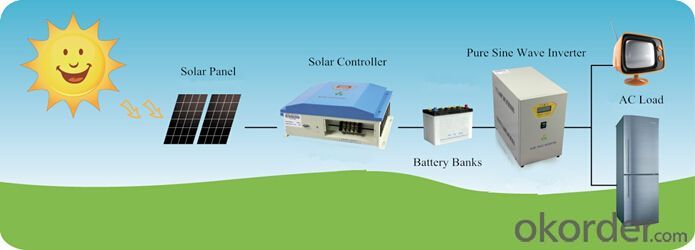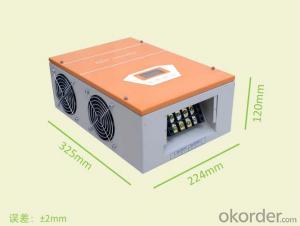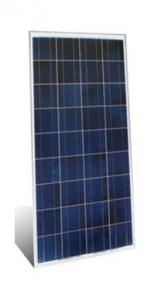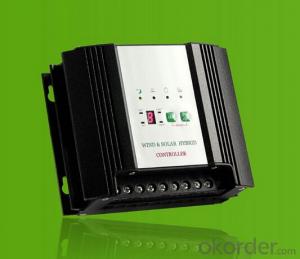Solar Charge Controller 3KW-MPPT Charging Function
- Loading Port:
- Shanghai
- Payment Terms:
- TT or LC
- Min Order Qty:
- 1 unit
- Supply Capability:
- 10000 unit/month
OKorder Service Pledge
OKorder Financial Service
You Might Also Like
I. PRODUCT INTRODUCTION
Solar controller is control device which can control solar panel and transform solar energy into electricity then store to the battery bank. Solar controller is the most important part in off-grid system, whose performance has much effect on life expectancy and operation of the whole system, especially the battery expectancy. Or battery service life will be shortened by over charge or over discharge.
II. PERFORMANCE FEATURES
Superior military-grade components to ensure the product stability.
Perfect protection function, thus the system has higher reliability.
Check and set all operation parameters as requirement from LCD display.
PWM stepless unload mode, which burn the excess power into Dump load, making the battery charging in best status.
III. APPLICATION AREAS
Standalone Photovoltaic power station
Standalone Domestic household photovoltaic power system
Mobil communication base stations, expressway and other non-residential regions.
Coastal islands, remote mountainous, border posts for regions shortage of or without electricity.
Government demonstration projects, landscape lighting project etc.
IV. 3KW TECHNICAL PARAMETERS
Product model | WS30-48-N00 | WS30-96-N00 | WS30-110-N00 | WS30-120-N00 | WS30-220-N00 |
Rated battery power | 48V | 96V | 110V | 120V | 220V |
Rated solar input power | 3kW | 3kW | 3kW | 3kW | 3kW |
Floating charge voltage | 58V | 116V | 133V | 145V | 266V |
Max Open Circuit Voltage | 100V | 200V | 230V | 250V | 458V |
Dimensions (L x W x H) | 442×307×172 mm | ||||
Net weight | 7kg | ||||
Display mode | LCD | ||||
Cooling | Fan | ||||
Protection level | IP20(Indoor) | ||||
Quiescent current | ≤20 mA | ||||
Protection functions | Battery over charge; battery anti-reverse-connection; solar reverse charge protection; solar anti-reverse-connection; lightning protection. | ||||
Ambient temperature | -20~+55℃ | ||||
Ambient humidity | 0~93%, without condensing | ||||
Working altitude | ≤4000m | ||||
In order to serve our customers better, our company can adjust parameter configuration according to customer’s requirement. | |||||
V. APPENDIX
Optional Functions | ||
Ø Temperature compensation function | Ø Dry-connect output signal function | Ø RS communication function |
Optional Accessories | ||
Ø Ethernet Module | Ø GPRS | Ø SD card storage module |
Ø RS485-USB converter | Ø RS485-RS232 converter | Ø RS232-USB converter |
Friendly reminder: Customers, who will order the solar controller, need to provide the following information | ||
Ø Rated battery voltage | Ø Rated solar power | Ø With or without additional functions |

- Q:What are the indicators and display features typically found on a solar controller?
- The indicators and display features typically found on a solar controller include battery voltage, charging current, load current, charging status, battery capacity, error codes, and various control buttons for mode selection and parameter adjustments.
- Q:What is the purpose of the maximum power point tracking feature on an MPPT solar controller?
- The purpose of the maximum power point tracking (MPPT) feature on an MPPT solar controller is to optimize the efficiency and output of the solar panel system. Solar panels have a specific voltage and current at which they can generate the maximum power output, known as the maximum power point (MPP). However, the MPP of the solar panel can vary due to changes in temperature, shading, and other environmental factors. The MPPT feature constantly monitors the voltage and current of the solar panel and adjusts the operating point to ensure that it operates at the MPP. By dynamically adjusting the voltage and current, the MPPT controller maximizes the power output from the solar panel and ensures that the maximum available energy is harvested from the sunlight. This feature is crucial in situations where the solar panel is subject to varying environmental conditions, as it allows the system to adapt and continuously operate at its optimum efficiency. By tracking the MPP, the MPPT controller ensures that the solar panel system operates at its highest possible power output, resulting in improved energy production and overall system performance. Furthermore, the MPPT feature also enables the solar panel system to be more compatible with different battery charging requirements. It allows for the conversion of excess energy that would otherwise be lost as heat, into usable energy for charging batteries or powering other devices. This capability makes MPPT solar controllers more versatile and efficient in various applications, such as off-grid systems, hybrid systems, and grid-tied systems with battery backup. In summary, the purpose of the MPPT feature on an MPPT solar controller is to optimize the power output of the solar panel system by continuously tracking the maximum power point. It ensures that the system operates at its highest efficiency, maximizes energy production, and improves compatibility with battery charging requirements.
- Q:How does a solar controller handle variations in ambient light conditions?
- A solar controller is designed to efficiently regulate and optimize the charging process of a solar panel system based on ambient light conditions. It uses advanced technology and algorithms to handle variations in light intensity and adjust the charging parameters accordingly. One of the primary functions of a solar controller is to monitor the voltage and current generated by the solar panels. When there is sufficient sunlight, the controller detects a higher voltage and current, indicating optimal charging conditions. In response, it adjusts the charging parameters to allow maximum power transfer from the panels to the battery, ensuring efficient charging. However, as ambient light conditions change, the solar controller needs to adapt to ensure the system's optimal performance. During low light conditions, such as cloudy or overcast days, the controller detects a drop in voltage and current. In such cases, it reduces the charging parameters to prevent overcharging the battery, which could lead to damage or reduced lifespan. Conversely, during periods of high light intensity, such as sunny days, the controller detects an increase in voltage and current. To prevent overloading the battery, it adjusts the charging parameters to limit the amount of power transferred, ensuring the battery is charged safely and efficiently. Furthermore, a solar controller may also incorporate additional features like temperature compensation to handle variations in ambient temperature. As temperature affects the charging process, the controller adjusts the charging parameters accordingly to compensate for temperature fluctuations and maintain optimal charging conditions. In summary, a solar controller effectively handles variations in ambient light conditions by continuously monitoring and adjusting the charging parameters based on the voltage and current generated by the solar panels. This ensures that the solar panel system operates efficiently, maximizes power transfer, and protects the battery from overcharging or other potential issues.
- Q:Can a solar controller be used with a solar-powered food processing facility?
- Yes, a solar controller can be used with a solar-powered food processing facility. A solar controller helps regulate and optimize the charging and discharging of batteries in a solar power system, ensuring efficient utilization of solar energy. This is crucial for a food processing facility as it requires a reliable and uninterrupted power supply. By using a solar controller, the facility can effectively manage and store solar energy to meet its power demands, making it a suitable choice for a solar-powered food processing facility.
- Q:Can a solar controller be used with solar-powered marine systems?
- Yes, a solar controller can be used with solar-powered marine systems. A solar controller helps regulate the charging process of the batteries in a solar-powered system, ensuring optimal charging and preventing overcharging or damage to the batteries. This is beneficial for marine systems as it helps to efficiently harness solar energy and extend the battery life, making it a suitable choice for powering various equipment onboard boats or other marine vessels.
- Q:How does a solar controller prevent damage from overloading of the load?
- A solar controller prevents damage from overloading of the load by continuously monitoring the current flowing through the system and regulating it to a safe level. It does this by automatically adjusting the voltage and current supplied to the load, ensuring that it does not exceed the controller's maximum capacity. This helps protect the load from excessive power and prevents any potential damage that could occur due to overloading.
- Q:Can a solar controller be used with a solar-powered fish farm?
- Yes, a solar controller can be used with a solar-powered fish farm. A solar controller regulates the charging and discharging of batteries in a solar power system, ensuring optimal performance and protection. In a solar-powered fish farm, the solar controller can be used to manage the solar panels' energy output, ensuring a constant and efficient power supply to the farm's infrastructure, such as pumps, aerators, and monitoring systems.
- Q:What is the maximum voltage drop allowed between the solar panels and the solar controller?
- The maximum voltage drop allowed between the solar panels and the solar controller will depend on the specific system requirements and components being used. It is recommended to consult the manufacturer's specifications or guidelines for the solar panels and solar controller to determine the acceptable voltage drop threshold.
- Q:What is the maximum self-consumption of a solar controller?
- The maximum self-consumption of a solar controller refers to the amount of energy it can use from the solar panels for its own operations. Typically, this value is quite low, ranging from 5-20 watts, as the main purpose of a solar controller is to regulate and optimize the energy flow from the panels to the battery or grid, rather than consume it.
- Q:How does a solar controller handle variations in solar panel orientation?
- A solar controller handles variations in solar panel orientation by continuously tracking the position of the sun and adjusting the output voltage and current accordingly. This ensures that the maximum power is extracted from the solar panels regardless of their orientation, maximizing energy production.
1. Manufacturer Overview |
|
|---|---|
| Location | |
| Year Established | |
| Annual Output Value | |
| Main Markets | |
| Company Certifications | |
2. Manufacturer Certificates |
|
|---|---|
| a) Certification Name | |
| Range | |
| Reference | |
| Validity Period | |
3. Manufacturer Capability |
|
|---|---|
| a)Trade Capacity | |
| Nearest Port | |
| Export Percentage | |
| No.of Employees in Trade Department | |
| Language Spoken: | |
| b)Factory Information | |
| Factory Size: | |
| No. of Production Lines | |
| Contract Manufacturing | |
| Product Price Range | |
Send your message to us
Solar Charge Controller 3KW-MPPT Charging Function
- Loading Port:
- Shanghai
- Payment Terms:
- TT or LC
- Min Order Qty:
- 1 unit
- Supply Capability:
- 10000 unit/month
OKorder Service Pledge
OKorder Financial Service
Similar products
New products
Hot products
Hot Searches
Related keywords





























